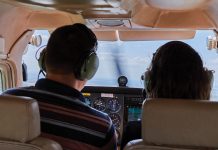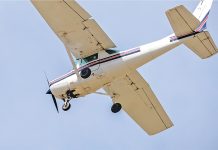ROY G. BIV has long been one of the world’s most colourful characters, while astronomers were once happy to declare that many volcanoes erupt mulberry jam sandwiches under normal pressure.
Mnemonics have been around since at least ancient Greek times — the two above relate to the colours of the spectrum and order of the planets (prior to Pluto’s demotion) — and it’s only fitting that aviation instructors have crafted a few memory aids of their own.
The chief flying instructor at Bathurst-based WardAir Flight Training, Catherine Fitzsimons, doesn’t know where IMPAIR came from originally. She believes it was handed down from instructor to instructor but says it’s a memory aid for approaching aerodromes, both controlled and non-controlled, every pilot should learn.
‘It’s a mnemonic to help people make radio calls in the correct format,’ Catherine says.
‘There are huge issues with people not making clear radio calls, people talking excessively, people giving their information in incorrect order, so then it makes it difficult for others to decipher it.
‘At all non-controlled aerodromes, safety is basically dependent on the see-and-avoid principle, which really needs to be rephrased these days as see, hear and avoid. Correct use of the radio allows people to establish situational awareness. It’s absolutely critical.’
So what does IIMPAIR actually stand for? Here’s Catherine’s rundown:
- I is for ident. To whom are you talking? For example, Cowra traffic, Bathurst traffic or Orange traffic.
- M is for make and me, so Cessna 182, Alpha-Bravo-Charlie.
- P is for position. ‘Position is always given as distance then bearing, e.g. 5 miles south. Or a location if it’s a published reporting point.’
- A is for altitude. ‘Position is always followed by your altitude. Maintaining situational awareness is challenging when somebody tells you their intentions before they even let you know where they are.’
- I – is for intentions. What are you going to do next?
- R is for received, request and the rest. That’s anything else that needs to be shared such as ‘ATIS [Automatic Terminal Information Service] received’ or a clearance request.
In more than two decades of flying, Catherine has heard most of the mistakes people make as they approach an uncontrolled aerodrome.
‘It varies enormously but it’s not uncommon for people to give their intentions but forget their position or give their position without their altitude,’ she says.
Too much information is almost as bad as too little. Catherine says telling everyone you’re inbound in a Cessna 172 and immediately declaring your intention to join for a left downwind on runway 17 for a touch and go, but forgetting to say where you’re arriving from, doesn’t help anyone.
‘Nobody needs to know what you’re going to be doing in 5 or 10 minutes, when you get there,’’ she says. ‘We need to know where you are right now and whether you’re a traffic issue for us or other aircraft.’
The chief flight instructor also warns that people are at risk of tuning out when others overcommunicate, particularly in a high-workload environment such as a cockpit on approach.
‘There needs to be judicious editing of your communication to make sure it facilitates situational awareness for other pilots and is limited to only what is immediately relevant,’ she says. ‘That will free up the air waves for other people to make their relevant communications.’
Everybody should also speak the same language when using what is, after all, a common traffic advisory frequency (CTAF).
Catherine says there is nothing more annoying than radio calls containing references to IFR waypoints and procedures that private and recreational pilots don’t know —and don’t need to know.
‘So IFR pilots – whether they’re flying RPT, air ambulance, helicopters, passenger jets or doing training flights – should make all of their calls in common CTAF language,’ she says.
She quickly adds: ‘Local pilots should also respect incoming IFR pilots who may not be familiar with their area and avoid making calls that reference local landmarks that would be difficult for, say, an inbound pilot unfamiliar with the area to understand.
‘Everybody in town might know where the piggery is or the pet food factory or Joe’s farm. That’s fine for locals but doesn’t really help other pilots coming in.’
The flight instructor believes good pilots are always keen to refresh their skills and learn new ones.
A passionate supporter of aviation safety, she teams with aviation journalist and fellow instructor Shelley Ross to run training trips that combine tourism with pilot education.
She also heartily recommends CASA’s free AvSafety seminars, workshops and e-learning modules.





Great mnemonic – I like it!
At one point in the article you’ve quoted it as “IIMPAIR”. The extra starting ‘I’ might be a typo, but I’d keep it, to remind me to Identify (again) whom I’m talking to on the radio before I even key the mike. The number of times I’ve broadcast on the wrong channel is …. embarrassing!
If the channel is not too busy, I try to reference both local/IFR waypoints and generic bearings/distances (e.g. “Five miles to the north outbound on the Temora track….”, or “One-five miles north-west approaching Whiskey Bravo inbound on the RNAV for Runway One-One” – that makes it easy both familiar and unfamiliar pilots to quickly grasp where you are. CTAFs are seldom THAT busy that you can’t afford an extra few words to make things clear.